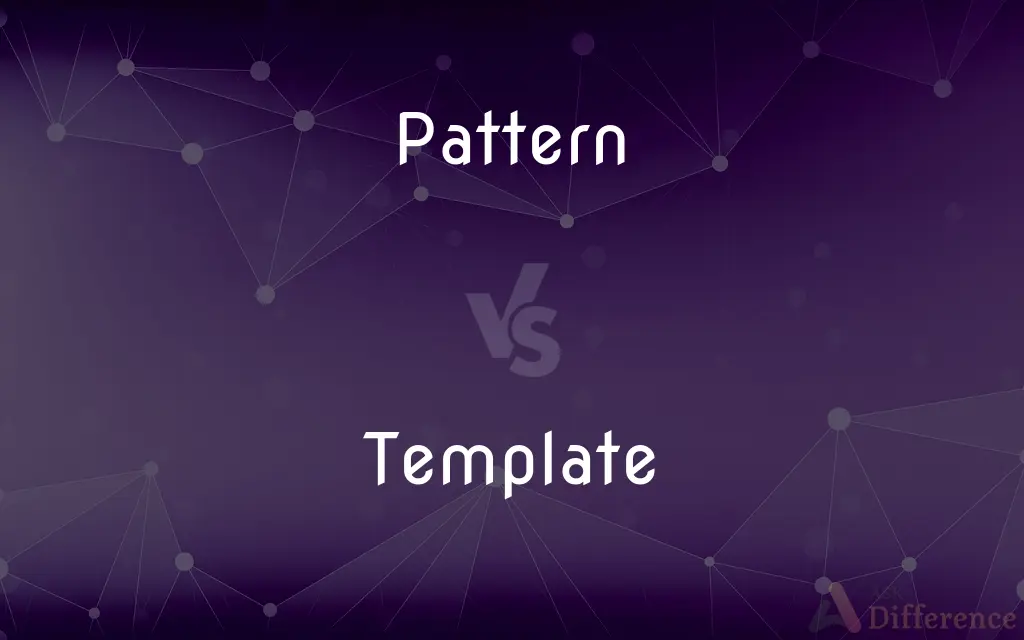Pattern vs. Template — What's the Difference?
By Urooj Arif & Fiza Rafique — Updated on March 31, 2024
A pattern is a regular and repeated form, model, or sequence, used as a reference for design or thought, whereas a template is a preset format or structure, serving as a guide for creating new items or documents.

Difference Between Pattern and Template
Table of Contents
ADVERTISEMENT
Key Differences
Patterns represent the underlying structure or model that is repeated or can be followed in various contexts. They emerge from practices, behaviors, designs, or natural occurrences, showcasing a consistent and identifiable form or sequence. On the other hand, templates are concrete tools or frameworks, often in the form of documents, software code, or physical molds, designed to be directly applied in the creation of new items or documents.
Patterns, being more abstract, are about recognizing and applying a recurring form or method across different situations, offering a high-level approach to solving similar problems. They are about understanding and implementing an idea that has been proven effective across various applications. Templates, in contrast, are about execution, providing a specific and often tangible format or blueprint to be filled in or followed. This difference highlights the conceptual versus the practical application of these tools in various fields.
While a pattern does not dictate the exact outcome and allows for variations in its application, a template is more prescriptive, outlining specific parameters and elements that should be included in the final product. For example, a design pattern in architecture might suggest principles for creating functional outdoor spaces, but the exact design will vary from one project to another. Conversely, a template for a business letter dictates the layout, salutation, body, and closing, requiring only the insertion of specific details.
The value of patterns lies in their ability to provide a tested approach for recurring challenges, fostering innovation and adaptation within a familiar framework. Meanwhile, templates streamline the creation process, reduce errors, and save time by offering a predefined format that can be customized with specific information. Both tools, in their respective capacities, enhance productivity and quality by providing guidance and structure.
Despite these differences, patterns and templates can be complementary. In many fields, patterns inform the development of templates, with the latter serving as a practical embodiment of the former. Understanding when and how to use each can significantly impact the efficiency and effectiveness of design, development, and problem-solving processes.
ADVERTISEMENT
Comparison Chart
Definition
A regular and repeated form, model, or sequence.
A preset format or structure for creating new items.
Nature
Abstract, conceptual.
Concrete, practical.
Application
Guides the development of solutions across fields.
Provides a direct guide for creating specific outputs.
Flexibility
Allows for variations in application.
More prescriptive with specific parameters.
Outcome
Conceptual framework for solving problems.
Specific items or documents following a predefined format.
Compare with Definitions
Pattern
An identifiable repetition of elements.
The quilt featured a beautiful pattern of interlocking circles.
Template
A pre-designed document format.
The company uses a template for all its reports to ensure consistency.
Pattern
A model or guide for behavior or design.
The psychologist studied patterns of behavior in social interactions.
Template
A framework in software for generating specific items.
We developed a website using a popular template.
Pattern
A template or model in software design.
We used a design pattern to solve the recurring problem efficiently.
Template
A standard layout for documents or data.
The researcher used a template for the survey to facilitate data analysis.
Pattern
An arrangement or sequence that is predictable.
The data revealed a pattern of increasing sales every quarter.
Template
A guide for achieving a specific look or format.
The decorator provided a template for setting up the event space.
Pattern
Reflects the underlying structure in nature or art.
The artist was inspired by the intricate patterns found in nature.
Template
A mold or form used in manufacturing.
The sculptor created a template to replicate the statue in bronze.
Pattern
A usually repeating artistic or decorative design
A paisley pattern.
Template
A shaped piece of rigid material used as a pattern for processes such as cutting out, shaping, or drilling.
Pattern
A design, motif or decoration, especially formed from regular repeated elements.
Template
A timber or plate used to distribute the weight in a wall or under a support.
Pattern
An image or diagram containing lines, usually horizontal, vertical, and diagonal, sometimes of varying widths, used to test the resolution of an optical instrument or the accuracy of reproduction of image copying or transmission equipment. Same as test pattern.
Template
A pattern or gauge, such as a thin metal plate with a cut pattern, used as a guide in making something accurately, as in woodworking or the carving of architectural profiles.
Pattern
A pattern is a regularity in the world, in human-made design, or in abstract ideas. As such, the elements of a pattern repeat in a predictable manner.
Template
A document or file having a preset format, used as a starting point for a particular application so that the format does not have to be recreated each time it is used
A loan amortization template for a spreadsheet program.
Pattern
A natural or accidental arrangement or sequence
The pattern of rainfall over the past year.
Template
An overlay that fits over all or part of a keyboard and has labels describing the functions of each key within a particular application.
Pattern
A plan, diagram, or model to be followed in making things
A dress pattern.
Template
A horizontal piece of stone or timber used to distribute weight or pressure, as over a door frame.
Pattern
A model or original used for imitation or as an archetype.
Template
(Biochemistry) A molecule of a nucleic acid, such as DNA, that serves as a pattern for the synthesis of a macromolecule, as of RNA.
Pattern
A composite of traits or features characteristic of an individual or a group
One's pattern of behavior.
Template
A physical object whose shape is used as a guide to make other objects.
Pattern
Form and style in an artistic work or body of artistic works.
Template
A generic model or pattern from which other objects are based or derived.
Pattern
The configuration of gunshots upon a target that is used as an indication of skill in shooting.
Template
(computing) document template file with a basic outline for a work
Pattern
The distribution and spread, around a targeted region, of spent shrapnel, bomb fragments, or shot from a shotgun.
Template
(molecular biology) A macromolecule which provides a pattern for the synthesis of another molecule.
Pattern
Enough material to make a complete garment.
Template
A partially defined class or function, that can be instantiated in a variety of ways depending on the instantiation arguments.
Pattern
A test pattern.
Template
A strip of metal used in boiler-making, pierced with a series of holes, and serving as a guide in marking out a line of rivet-holes.
Pattern
The flight path of an aircraft about to land
A flight pattern.
Template
To set up or mark off using a template.
Pattern
(Football) A pass pattern.
Template
To provide a template or pattern for.
Pattern
To make, mold, or design by following a pattern
We patterned this plan on the previous one. My daughter patterned her military career after her father's.
Template
Same as Templet.
Pattern
To cover or ornament with a design or pattern.
Template
A model or standard for making comparisons
Pattern
To make a pattern.
Pattern
Model, example.
Pattern
Something from which a copy is made; a model or outline.
Pattern
Someone or something seen as an example to be imitated; an exemplar.
Pattern
A copy.
Pattern
A sample; of coins, an example which was struck but never minted.
Pattern
A representative example.
Pattern
(US) The material needed to make a piece of clothing.
Pattern
(textiles) The paper or cardboard template from which the parts of a garment are traced onto fabric prior to cutting out and assembling.
Pattern
A full-sized model around which a mould of sand is made, to receive the melted metal. It is usually made of wood and in several parts, so as to be removed from the mould without damage.
Pattern
(computing) A text string containing wildcards, used for matching.
There were no files matching the pattern
*.txt.Pattern
A design pattern.
Pattern
Coherent or decorative arrangement.
Pattern
A naturally-occurring or random arrangement of shapes, colours etc. which have a regular or decorative effect.
Pattern
The given spread, range etc. of shot fired from a gun.
Pattern
A particular sequence of events, facts etc. which can be understood, used to predict the future, or seen to have a mathematical, geometric, statistical etc. relationship.
Pattern
(linguistics) An intelligible arrangement in a given area of language.
Pattern
A sequence of notes, percussion etc. in a tracker module, usable once or many times within the song.
Pattern
To apply a pattern.
Pattern
To make or design (anything) by, from, or after, something that serves as a pattern; to copy; to model; to imitate.
Pattern
To follow an example.
Pattern
To fit into a pattern.
Pattern
(transitive) To serve as an example for.
Pattern
To observe an animal closely over time in order to discern its habitual movements and behaviours.
Pattern
(MLE) To arrange, to organise, to fix.
Pattern
Of or in accordance with a usual pattern, or type; model; ideal.
Pattern
Anything proposed for imitation; an archetype; an exemplar; that which is to be, or is worthy to be, copied or imitated; as, a pattern of a machine.
I will be the pattern of all patience.
Pattern
A part showing the figure or quality of the whole; a specimen; a sample; an example; an instance.
He compares the pattern with the whole piece.
Pattern
Stuff sufficient for a garment; as, a dress pattern.
Pattern
Figure or style of decoration; design; as, wall paper of a beautiful pattern.
Pattern
Something made after a model; a copy.
The patterns of things in the heavens.
Pattern
Anything cut or formed to serve as a guide to cutting or forming objects; as, a dressmaker's pattern.
Pattern
A full-sized model around which a mold of sand is made, to receive the melted metal. It is usually made of wood and in several parts, so as to be removed from the mold without injuring it.
Pattern
A recognizable characteristic relationship or set of relationships between the members of any set of objects or actions, or the properties of the members; also, the set having a definable relationship between its members.
Pattern
A diagram showing the distribution of the pellets of a shotgun on a vertical target perpendicular to the plane of fire.
Pattern
The recommended flight path for an airplane to follow as it approaches an airport for a landing. Same as landing pattern.
Pattern
To make or design (anything) by, from, or after, something that serves as a pattern; to copy; to model; to imitate.
[A temple] patterned from that which Adam reared in Paradise.
Pattern
To serve as an example for; also, to parallel.
Pattern
A perceptual structure;
The composition presents problems for students of musical form
A visual pattern must include not only objects but the spaces between them
Pattern
A customary way of operation or behavior;
It is their practice to give annual raises
They changed their dietary pattern
Pattern
A decorative or artistic work;
The coach had a design on the doors
Pattern
Something regarded as a normative example;
The convention of not naming the main character
Violence is the rule not the exception
His formula for impressing visitors
Pattern
A model considered worthy of imitation;
The American constitution has provided a pattern for many republics
Pattern
Something intended as a guide for making something else;
A blueprint for a house
A pattern for a skirt
Pattern
The path that is prescribed for an airplane that is preparing to land at an airport;
The traffic patterns around O'Hare are very crowded
They stayed in the pattern until the fog lifted
Pattern
Graphical representation (in polar or cartesian coordinates) of the spatial distribution of radiation from an antenna as a function of angle
Pattern
Plan or create according to a model or models
Pattern
Form a pattern;
These sentences pattern like the ones we studied before
Common Curiosities
How do templates save time?
Templates save time by offering a predefined format that only needs customization, eliminating the need to start from scratch.
Can a pattern become a template?
Yes, a pattern can inform the creation of a template, translating conceptual guidance into a practical application tool.
Is a template always physical?
No, templates can be digital or physical, ranging from document formats to software frameworks.
What's the main difference between a pattern and a template?
The main difference is that patterns are abstract models or sequences for guiding thought or design, while templates are concrete formats or structures for creating specific items.
Why are patterns important in design?
Patterns provide a proven approach to solving design problems, facilitating innovation within a familiar framework.
Can a template be customized?
Yes, templates are designed to be customized with specific details, although they have a fixed structure.
What makes a good template?
A good template is easy to use, clearly structured, and customizable, serving its intended purpose efficiently.
How do patterns and templates contribute to efficiency?
Patterns guide the conceptual approach to problems, while templates streamline the creation process, both enhancing efficiency.
Are patterns specific to certain fields?
No, patterns are used across various fields, from software engineering to psychology, as conceptual guides.
How does one choose between using a pattern or a template?
The choice depends on the task: use a pattern for conceptual guidance and a template for practical, format-specific creation.
Is it possible to have multiple templates for the same purpose?
Yes, there can be multiple templates for the same purpose, offering different layouts or structures.
Can the use of templates stifle creativity?
While templates streamline processes, over-reliance on them without allowing for customization can limit creative expression.
How do patterns and templates interact in software development?
In software development, patterns provide the conceptual framework for solving problems, while templates can be used to write code that follows these patterns, linking high-level design with practical implementation.
Are there templates for every kind of document or design?
There are templates for a wide range of purposes, but not for every conceivable document or design. Custom templates can be created as needed.
Do patterns evolve over time?
Yes, as new solutions and approaches emerge, patterns can evolve to incorporate these advancements.
Share Your Discovery

Previous Comparison
Lively vs. Reserved
Next Comparison
Prawn vs. CockroachAuthor Spotlight
Written by
Urooj ArifUrooj is a skilled content writer at Ask Difference, known for her exceptional ability to simplify complex topics into engaging and informative content. With a passion for research and a flair for clear, concise writing, she consistently delivers articles that resonate with our diverse audience.
Co-written by
Fiza RafiqueFiza Rafique is a skilled content writer at AskDifference.com, where she meticulously refines and enhances written pieces. Drawing from her vast editorial expertise, Fiza ensures clarity, accuracy, and precision in every article. Passionate about language, she continually seeks to elevate the quality of content for readers worldwide.














































